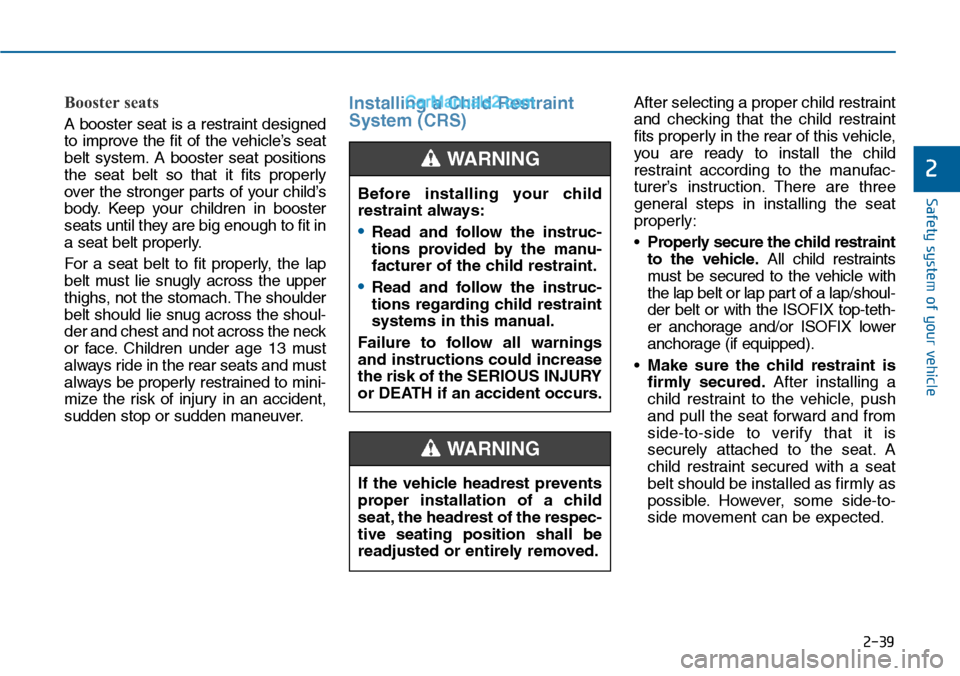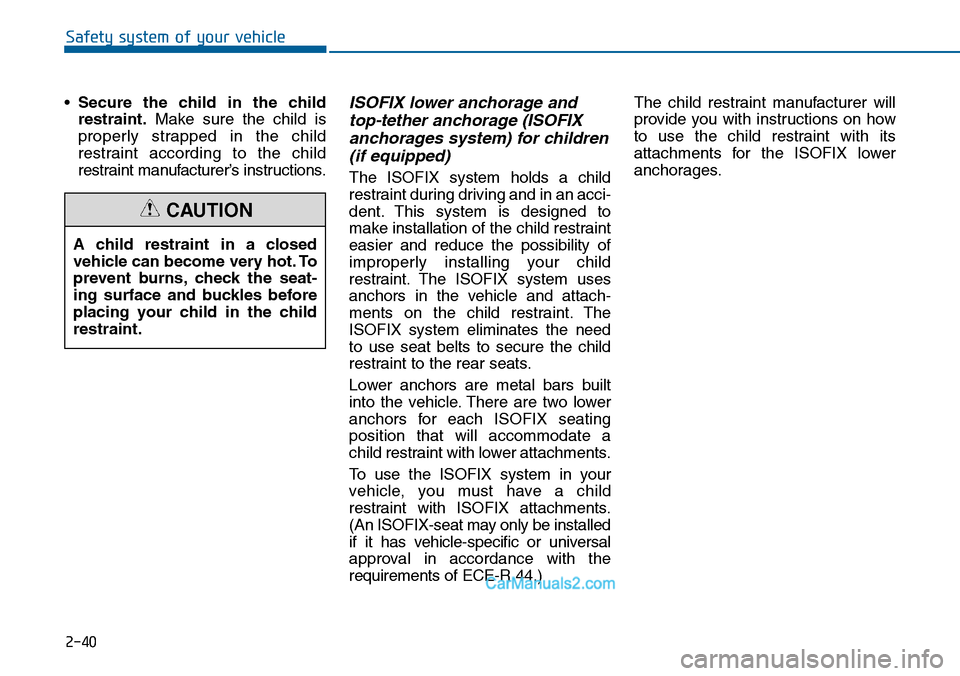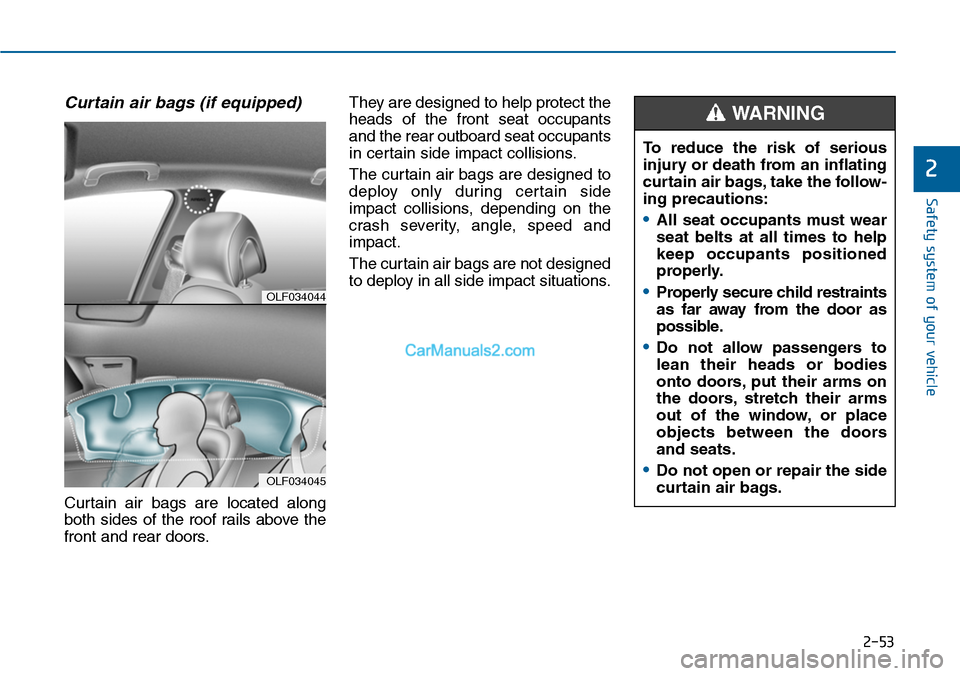2014 Hyundai Sonata seats
[x] Cancel search: seatsPage 68 of 665

2-39
Safety system of your vehicle
2
Booster seats
A booster seat is a restraint designed
to improve the fit of the vehicle’s seat
belt system. A booster seat positions
the seat belt so that it fits properly
over the stronger par ts of your child’s
body. Keep your children in booster
seats until they are big enough to fit in
a seat belt properly.
For a seat belt to fit properly, the lap
belt must lie snugly across the upper
thighs, not the stomach. The shoulder
belt should lie snug across the shoul-
der and chest and not across the neck
or face. Children under age 13 must
always ride in the rear seats and must
always be properly restrained to mini-
mize the risk of injury in an accident,
sudden stop or sudden maneuver.
Installing a Child Restraint
System (CRS)
After selecting a proper child restraint
and checking that the child restraint
fits properly in the rear of this vehicle,
you are ready to install the child
restraint according to the manufac-
turer’s instruction. There are three
general steps in installing the seat
properly:
•Properly secure the child restraint
to the vehicle.All child restraints
must be secured to the vehicle with
the lap belt or lap part of a lap/shoul-
der belt or with the ISOFIX top-teth-
er anchorage and/or ISOFIX lower
anchorage (if equipped).
•Make sure the child restraint is
firmly secured.After installing a
child restraint to the vehicle, push
and pull the seat forward and from
side-to-side to verify that it is
securely attached to the seat. A
child restraint secured with a seat
belt should be installed as firmly as
possible. However, some side-to-
side movement can be expected.
Before installing your child
restraint always:
•Read and follow the instruc-
tions provided by the manu-
facturer of the child restraint.
•Read and follow the instruc-
tions regarding child restraint
systems in this manual.
Failure to follow all warnings
and instructions could increase
the risk of the SERIOUS INJURY
or DEATH if an accident occurs.
WARNING
If the vehicle headrest prevents
proper installation of a child
seat, the headrest of the respec-
tive seating position shall be
readjusted or entirely removed.
WARNING
Page 69 of 665

2-40
Safety system of your vehicle
•Secure the child in the child
restraint.Make sure the child is
properly strapped in the child
restraint according to the child
restraint manufacturer’s instructions.
ISOFIX lower anchorage and
top-tether anchorage (ISOFIX
anchorages system) for children
(if equipped)
The ISOFIX system holds a child
restraint during driving and in an acci-
dent. This system is designed to
make installation of the child restraint
easier and reduce the possibility of
improperly installing your child
restraint. The ISOFIX system uses
anchors in the vehicle and attach-
ments on the child restraint. The
ISOFIX system eliminates the need
to use seat belts to secure the child
restraint to the rear seats.
Lower anchors are metal bars built
into the vehicle. There are two lower
anchors for each ISOFIX seating
position that will accommodate a
child restraint with lower attachments.
To u s e t h e I S O F I X s y s t e m i n y o u r
vehicle, you must have a child
restraint with ISOFIX attachments.
(An ISOFIX-seat may only be installed
if it has vehicle-specific or universal
approval in accordance with the
requirements of ECE-R 44.)
The child restraint manufacturer will
provide you with instructions on how
to use the child restraint with its
attachments for the ISOFIX lower
anchorages.
A child restraint in a closed
vehicle can become very hot. To
prevent burns, check the seat-
ing surface and buckles before
placing your child in the child
restraint.
CAUTION
Page 70 of 665

2-41
Safety system of your vehicle
2
ISOFIX lower anchorages have been
provided in the left and right outboard
rear seating positions. Their locations
are shown in the illustration. There
are no ISOFIX lower anchorages pro-
vided for the center rear seating posi-
tion.
The ISOFIX lower anchorages posi-
tion indicator symbols are located on
the left and right rear seat backs to
identify the position of the ISOFIX
lower anchorages in your vehicle
(see arrows in illustration).
Both rear outboard seats are
equipped with a pair of ISOFIX lower
anchorages as well as a correspon-
ding top-tether anchorage on the
back side of the rear seats.
(CRS with universal approval to ECE-
R44 need to be fixed additionally with
a top-tether strap connected to the
corresponding top-tether anchorage
point on the back side of the rear
seats.)
OLF034036
Do not attempt to install a child
restraint system using ISOFIX
lower anchorages in the rear cen-
ter seating position. There are no
ISOFIX lower anchorages provid-
ed for this seat. Using the out-
board seat anchorages can dam-
age the anchorages which may
break or fail in a collision result-
ing in serious injury or death.
WARNING
OLF034037
ISOFIX Lower AnchoragePosition Indicator
Page 74 of 665

2-45
Safety system of your vehicle
2
Securing a child restraint with
a lap/shoulder belt
When not using the ISOFIX anchor-
ages system, all child restraints must
be secured to a vehicle rear seat with
the lap part of a lap/shoulder belt.
Installing a child restraint with a
lap/shoulder belt
To install a child restraint system on
the rear seats, do the following:
1. Place the child restraint system on
a rear seat and route the lap/shoul-
der belt around or through the
restraint, following the restraint
manufacturer’s instructions.
Be sure the seat belt webbing is not
twisted.
When using the rear center seat
belt, you should also refer to the “3-
point Rear Center Seat Belt” sec-
tion in this chapter.
NOTICE
ALWAYS place a rear-facing
child restraint in the rear seat of
the vehicle.
Placing a rear-facing child
restraint in the front seat can
result in serious injury or death
if the child restraint is struck by
an inflating air bag.
WARNING
OLMB033044
Page 76 of 665

2-47
Safety system of your vehicle
2
Child Seat Restraint Suitability for Seat Position using the Seat Belt - For Europe
Use child safety seats that have been officially approved and are appropriate for your children.
When using the child safety seats, refer to the following table.
U:Suitable for "universal" category restraints approved for use in this mass group
UF : suitable for forward-facing "universal" category restraints approved for use in this mass group
X:Seat position not suitable for children in this mass group
Age groupSeating position
Front passengerRear outboardRear center
0 : Up to 10 kg
(0 - 9 months)XUUF
0+ : Up to 13 kg
(0 - 2 years)XUUF
I : 9 kg to 18 kg
(9 months - 4 years)XUUF
II & III : 15 kg to 36 kg
(4 - 12 years)XUFUF
We recommend that a child restraint seat be installed in the rear seat. To ensure the safety of your
child, the front passenger’s air bag must be deactivated when it should be necessary to install a child
restraint seat on the front passenger seat in exceptional circumstances.
WARNING
Page 79 of 665

2-50
Safety system of your vehicle
Ve h i c l e s a r e e q u i p p e d w i t h a
Supplemental Air Bag System for the
driver’s seat and front passenger’s
seats.
The front air bags are designed to
supplement the three-point seat
belts. For these air bags to provide
protection, the seat belts must be
worn at all times when driving.
Yo u c a n b e s e v e r e l y i n j u r e d o r k i l l e d
in an accident if you are not wearing
a seat belt. Air bags are designed to
supplement seat belts, but do not
replace them. Also, air bags are not
designed to deploy in every collision.
In some accidents, the seat belts are
the only restraint protecting you.
AIR BAG SAFETY PRECAUTIONS
ALWAYS use seat belts and child restraints - every trip, every time,
everyone! Even with air bags, you can be seriously injured or killed in
a collision if you are improperly belted or not wearing your seat belt
when the air bag inflates.
NEVER place a child in any child restraint or booster seat in the front
passenger seat. An inflating air bag could forcefully strike the infant
or child causing serious or fatal injuries.
ABC - Always Buckle Children under age 13 in the back seat. It is the
safest place for children of any age to ride. If a child age 13 or older
must be seated in the front seat, he or she must be properly belted
and the seat should be moved as far back as possible.
All occupants should sit upright with the seatback in an upright posi-
tion, centered on the seat cushion with their seat belt on, legs com-
fortably extended and their feet on the floor until the vehicle is parked
and the engine is turned off. If an occupant is out of position during
an accident, the rapidly deploying air bag may forcefully contact the
occupant causing serious or fatal injuries.
Yo u a n d y o u r p a s s e n g e r s s h o u l d n e v e r s i t o r l e a n u n n e c e s s a r i l y
close to the air bags or lean against the door or center console.
Move your seat as far back as possible from front air bags, while still
maintaining control of the vehicle.
WARNING
Page 81 of 665

2-52
Safety system of your vehicle
Side air bags (if equipped)
Yo u r v e h i c l e i s e q u i p p e d w i t h a s i d e a i r
bag in each front seat. The purpose of
the air bag is to provide the vehicle’s
driver and the front passenger with
additional protection than that offered
by the seat belt alone.
The side air bags are designed to
deploy only during certain side impact
collisions, depending on the crash
severity, angle, speed and point of
impact.
The side air bags are not designed to
deploy in all side impact situations.
OLF034042
OLF034043
(Continued)
•Do not use any accessory
seat covers. This could reduce
or prevent the effectiveness
of the system.
•Do not place any objects over
the air bag or between the air
bag and yourself.
•Do not place any objects
between the door and the
seat. They may become dan-
gerous projectiles if the side
air bag inflates.
•Do not install any accessories
on the side or near the side air
bags.
•Do not cause impact to the
doors when the ignition
switch is in the ON position or
this may cause the side air
bags to inflate.
•If the seat or seat cover is
damaged, we recommend that
the system be serviced by an
authorized HYUNDAI dealer.
To reduce the risk of serious
injury or death from an inflating
side air bag, take the following
precautions:
•Seat belts must be worn at all
times to help keep occupants
positioned properly.
•Do not allow passengers to
lean their heads or bodies onto
doors, put their arms on the
doors, stretch their arms out of
the window, or place objects
between the doors and seats.
•Hold the steering wheel at the 9
o’clock and 3 o’clock positions,
to minimize the risk of injuries
to your hands and arms.
(Continued)
WARNING
Page 82 of 665

2-53
Safety system of your vehicle
2
Curtain air bags (if equipped)
Curtain air bags are located along
both sides of the roof rails above the
front and rear doors.
They are designed to help protect the
heads of the front seat occupants
and the rear outboard seat occupants
in certain side impact collisions.
The curtain air bags are designed to
deploy only during certain side
impact collisions, depending on the
crash severity, angle, speed and
impact.
The curtain air bags are not designed
to deploy in all side impact situations.OLF034044
OLF034045
To reduce the risk of serious
injury or death from an inflating
curtain air bags, take the follow-
ing precautions:
•All seat occupants must wear
seat belts at all times to help
keep occupants positioned
properly.
•Properly secure child restraints
as far away from the door as
possible.
•Do not allow passengers to
lean their heads or bodies
onto doors, put their arms on
the doors, stretch their arms
out of the window, or place
objects between the doors
and seats.
•Do not open or repair the side
curtain air bags.
WARNING